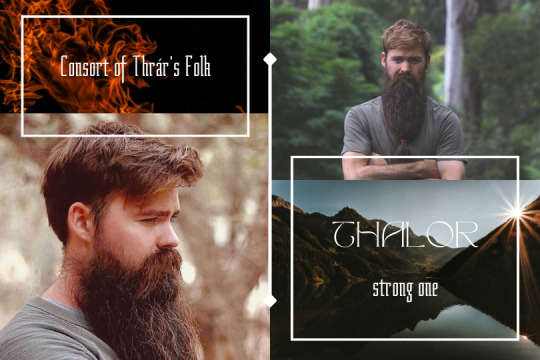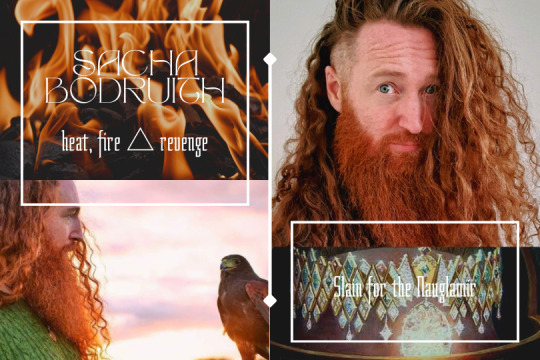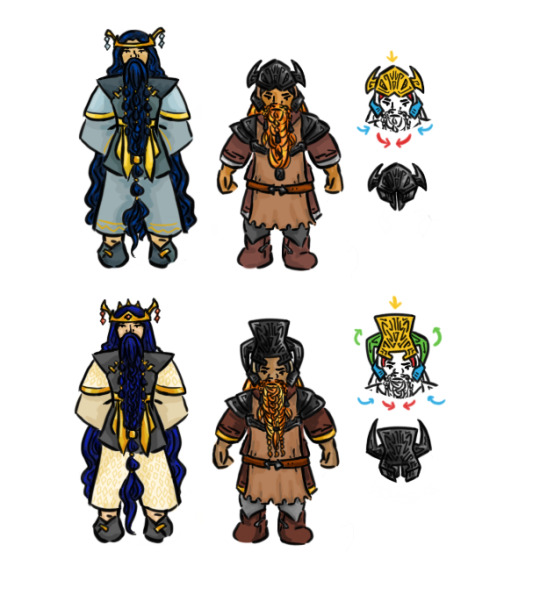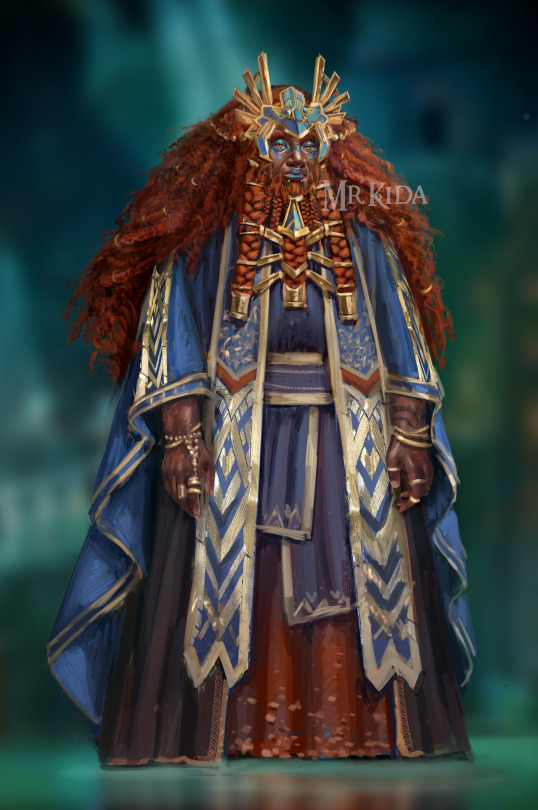#firebeard
Video
youtube
FireBeard - Comin’ From The Future - (Official Visualizer)
#youtube#firebeard#comin' from the future#video#heavy metal#hard rock#2024#hungary#magyar#stoner#doom
4 notes
·
View notes
Video
youtube
FireBeard - Flight To Nowhere - (Official Live Video)
fb
2 notes
·
View notes
Text
youtube
Firebeard - Feed My Soul / live / Made In Pécs Fesztivál / 2023. 01. 08. / Est Cafe
#video#hard rock#heavy metal#stoner#doom#firebeard#hungary#magyar#feed my soul#made in pécs#est cafe#Youtube
2 notes
·
View notes
Photo

Just a lil baby dwarf being kissed on the cheek 8)
#Firebeards#Ered Luin dwarves#Clans of Ered Luin#the seven clans of the dwarves#the hobbit#tolkien#the lord of the rings#lotr#The Lord of the Rings: The Rings of Power#lotrtrop#lotro#lord of the rings online#my art#dwarves#dwarfling#baby dwarf#dwarven parents#the firebeard clan
25K notes
·
View notes
Text
I wonder if Elrond saw Legolas and Gimli together in Minas Tirith. He must have stayed for his daughter’s wedding, so he probably did.
I wonder if, for a moment, he saw himself and Durin.
Legolas and Gimli have a different dynamic but for a moment he catches Legolas laughing and Gimli grumbling good-heartedly, that familiar dwarvish smirk just barely hidden by his beard and suddenly he’s back in Khazad-dûm. Sharing a meal with Durin as Disa tries in vain to get his two dwarrowlings to settle down and have their supper.
#rings of power#the rings of power#Elrond#Durin#Look#you can't give me one of the best and most wholesome friendships I've ever seen#and not expect the feels#and it feels different to Legolas and Gimli#in a really good way#this friendship is old and comfy#and that scene with the supposedly sacred table still makes me laugh#I'm sure it doesn't help that Gimli and Durin are both firebeards#and that Gimli himself is of the line of Durin#just#poor Elrond#always outliving everyone he loves
1K notes
·
View notes
Text

@nerevar-quote-and-star
138 notes
·
View notes
Text
Overlord season 4 in a nutshell...
(Please check out my YouTube channel lol)
#overlord#ainz ooal gown#jircniv rune farlord el-nix#emperor jircniv#princess renner#rener theiere chardelon ryne vaiself#gondo firebeard#meme#shitpost
560 notes
·
View notes
Text

looks like i'll be able to remake Kastyn soon with updated facial Hair 🔥
#baldur's gate 3#bg3edit#bg3#baldurs gate iii#bgiii#c: kastyn firebeard#tav#bg3 mods#my problem is that this is my favorite Dwarf face preset#so everytime i want to make another dwarf they end up being Kastyn's twin :/#bg3sd.gif#bg3 dwarf
35 notes
·
View notes
Text
Dwarves:
Masterlist
Longbeards (Durin's Folk): Durin´s, the eldest of the Dwarven fathers, folk are one of the longest lived dwarf clanes and can, they live long even for other dwarves. Their capital is Khazad-dûm, later known as Moria, located in the Misty Mountains. They speak Sindarin (common) and Khuzdul. Longbeards can be around 250 years, and presumably have longer beards than the rest of the Dwarves. The Longbeards woke in Gundabad.
Firebeards: The Firebeards are residents of Belegost, Nogros, and the Blue Mountains. They speak Sindarin (common) and Khuzdul. Firebeards don´t live as long as Durin´s folk so they can probably be around 200 years old and presumably have red beards. The Firebeards woke in the Blue Mountains with the Broadbeams.
Broadbeams: The Broadbeams are residents of Belegost, Nogros, and the Blue Mountains. They speak Sindarin (common) and Khuzdul. Broadbeams don´t live as long as Durin´s folk so they can probably be around 200 years old. Nothing is said about their appearance. The Broadbeams woke in the Blue Mountains with the Firebeards.
Ironfists: The Ironfists are residents of Rhûn. Looking at geography Rhûn is in the east so they presumably have darker skin tones than the other Dwarves. They speak Sindarin (common), Khuzdul, and the language of Rhûn. Ironfists don´t live as long as Durin´s folk although they were said too to live about 250 years, so they have been close to the Longbeards in life span. It is unknown where the Ironfists woke other than that they woke with the Stiffbeards.
Stiffbeards: The Stiffbeards are residents of Rhûn. Looking at geography Rhûn is in the east so they presumably have darker skin tones than the other Dwarves. They speak Sindarin (common), Khuzdul, and the language of Rhûn. Stiffbeards don´t live as long as Durin´s folk although they were said too to live about 250 years, so they have been close to the Longbeards in life span. It is unknown where the Stiffbeards woke other than that they woke with the Ironfists.
Blacklocks: The Blacklocks are also residents of Rhûn. Looking at geography Rhûn is in the east so they presumably have darker skin tones than the other Dwarves, and for their name black hair or locks. They speak Sindarin (common), Khuzdul, and the language of Rhûn. Blacklocks don´t live as long as Durin´s folk although they were said too to live about 250 years, so they have been close to the Longbeards in life span. It is unknown where the Blacklocks woke other than that they woke with the Stonefoots.
Stonefoots: The Stonefoots are also residents of Rhûn. Looking at geography Rhûn is in the east so they presumably have darker skin tones than the other Dwarves, and for their name black hair or locks. They speak Sindarin (common), Khuzdul, and the language of Rhûn. Stonefoots don´t live as long as Durin´s folk although they were said too to live about 250 years, so they have been close to the Longbeards in life span. It is unknown where the Blacklocks woke other than that they woke with the Blacklocks.
Pros: Dwarves start out as devoted to Aule no matter what, but if you play dwarf and want to be devoted to another, or be loose of any ties to the Vala you have to manually do that. Here you can change to any Vala you want or just want since you are his child and will always be in his favor no matter what. You will have + 2 on strength and + 4 when smithing.
Cons: Most elvers, except the Noldor and Avarin, bear distrust towards dwarves. They are slower than others and move at half the speed of others. They have disadvantaged on insight as they are distrustful in nature, and on deception and sleight of hand, unless their class gives them advantage.
#jrr tolkien#tolkien#silmarillion#silmarillion d&d#dwarves#durin#durins folk#longbeards#firebeards#broadbeams#ironfist#stiffbeards#blacklocks#stonefoots
11 notes
·
View notes
Text
Elisif the Fair, hyped on pumpkin spice and sugar: It's been the Witches Festival for three days and it's not even the Witches Festival yet!
Falk Firebeard: Shor save us.
#elisif the fair#jarl elisif#blue palace#falk firebeard#solitude#witches festival#nerevar queue and star#incorrect quotes#incorrect elder scrolls#incorrect skyrim quotes#tes#the elder scrolls#skyrim#the elder scrolls v: skyrim#source: twitter
24 notes
·
View notes
Text
Some of my favourite characters in skyrim, and why 👹
Balgruuf The Greater: i think this speaks for itself tbh, my favourite Jarl
Balimund: I don't actually know, kinda just looked at him and said "yes, he's the one." Or at least one of them anyway lmfao
Brynjolf: cocky thief with a *small amount* of issues, need i say more?
Captain Aldis: Self Explanatory. he's pretty, good personality, wants books, and lots of muscle? Yes please
Captain Gjalund Salt-Sage: idk he just smiled at my character once and it did things LMFAOOO
Captain Lonely-Gale: Father? Sorry, Father? Sorry-
Falk Firebeard: Steward whos probably a borderline alcoholic? Possibly involved in scandals? Pretty? Yes please
Glover Mallory: no.1 Smith, thief gone good, first I've found to sell Daedric stuff, what more can you want?
Halbarn Iron-Fur: personality is on point, easily lovable, one of my favourite smiths along side Glover
Idolaf Battle-Born: Dilf with an attitude, fuck yeah
Igmund: As with Balimund, I'm not even sure
Korir: if Siddgeir and Balgruuf had a child, he's them. Personality wise anyway, bit of a wanker tho
Kraldar: idk he's just there and he's sweet
Roggi Knot-Beard: Our favourite alcoholic, lovable character, ray of sunshine.
Rune: He's baby. Todd let me help him find out who his parents are i beg
Torbjorn Shatter-Shield: Dilf, I feel so bad tho oh my god, I killed Nilsine in Muiri's quest... never again. I don't need the bonus.
Ulfric Stormcloak: I can fix him
#balgruuf the greater#skyrim#idolaf battle-born#captain lonely-gale#jarl balgruuf#the elder scrolls#balimund#brynjolf#captain lonely gale#captain aldis#Gjalund Salt-Sage#Captain Gjalund#falk firebeard#Glover Mallory#Halbarn Iron-Fur#he's underrated#Igmund#korir#kraldar#Roggi Knot-Beard#Rune#ulfric stormcloak
14 notes
·
View notes
Photo




dwarves of middle-earth △ firebeards and broadbeams △ headcanon disclaimer △ @khazadweek day one △ first age // family
Azaghâl was the King of Belegost during much of the First Age of the Sun. He earned his use-name from his prowess in battle, and proudly wore it all his days, though his decision to take an outer name in Khuzdul was unorthodox. Yet so widely beloved was he by his people that few spoke against this choice, and the Firebeards of Gabilgathol defended him fiercely against the few Broadbeams of Tumunzahar who dared comment on Azaghâl’s name.
The spouse of Azaghâl was Thalor, a lesser prince of Nogrod who gained his name, and great wealth, in his travels in the eastern lands later known as Eriador. Thalor boasted even of having visited Khazad-dûm, though many doubted the truth of this tale in particular. Thalor’s dowry to Azaghâl upon their marriage was a grand helm crafted by none other than Telchar himself, greatest of Nogrod’s smiths, and a friend of his father. Upon this helm was a golden figure of the wyrm Glaurung, symbolizing Azaghâl’s power in combat. Thalor bore Azaghâl two sons, and the pair were deeply affectionate with one another.
Often Azaghâl and Thalor would travel together into Beleriand, trading with Caranthir the dark and Elu Thingol and later the Edain as well. On one such journey along the Dwarf-road Azaghâl’s grandfather had constructed along the River Ascar when their company was assaulted by a legion of orcs. Though Azaghâl and his folk put up a mighty battle, there were simply too many enemies for them to take down, and after a pitched battle through the night, more than half of the dwarves had been slaughtered.
They would all have perished had not Maedhros the tall, Lord of Himring and brother to Caranthir, come suddenly to their rescue. Maedhros’ mounted elves descended upon the orcs, slaying many and sending the rest scattering only to be chased down by the warriors of Himring. Maedhros himself saved Azaghâl’s life by taking a blow meant for the dwarven king, and in deepest gratitude Azaghâl gave to him the Dragon-helm and pledged a life-debt to him.
Thus began a lifelong friendship and alliance between elf and dwarf. Maedhros and his soldiers escorted Azaghâl, Thalor, and the surviving dwarves back to Belegost, and attended the solemn burials of those slain in battle. Afterward, Maedhros and Azaghâl spent many days in conversation, learning much of each others’ peoples and becoming fast friends. It was Maedhros who gave Azaghâl’s sons their use-names, Sacha and Fimli, though these pronunciations were likely an alteration of the original Sindarin words.
When the Sudden Flame descended upon the peoples of Beleriand, Azaghâl left Thalor to fortify Gabilgathol and himself set out into the elven lands seeking battle. His unexpected arrival to Caranthir’s settlement upon the shores of Lake Helevorn allowed the elves there to hold their siege for three more nights, ensuring many of their goods and people could escape southward to Amon Ereb. In the coming years, Azaghâl was one of the first lords and kings to enter into the Union of Maedhros, ever eager to wage war against the Enemy and further prove his skill in battle.
When the fateful Fifth Battle dawned, Azaghâl and his warriors marched with the eastern contingent. As the battle turned ill, he refused to flee, and his stout-hearted soldiers stood with him against the mighty wyrm Glaurung, whose likeness adorned the very helm Azaghâl once bore. As the elves fell back in retreat, the dwarves of Belegost hewed away at the dragon’s scales, for the make of their axes was so sharp and strong that nothing could withstand their blows.
Yet when Glaurung turned the force of his rage upon the dwarven king, Azaghâl was at last struck down and the dragon crawled over his body to defile it. This would turn to the wyrm’s undoing, for with his last breath, Azaghâl drove a knife into Glaurung’s belly and so wounded him that he fled the field with many of the dismayed beasts of Angband following. Thus died Azaghâl, King of Belegost, and his people raised up his body and bore him away with slow steps and dirge of deep voices. Such was the power of dwarven Song that even though they heeded not their foes, none dared attack them, and they did not halt until they returned to Gabilgathol to intern their king in his mountainside tomb.
Sacha, eldest of Azaghâl’s sons, was crowned King in the days following. Thalor his father retreated in grief and lived only a few years longer before he wasted away in sorrow. Blaming his fathers’ deaths on their friendship with the elves, Sacha turned Maedhros away from Belegost in his hour of need and closed the doors of Gabilgathol to any outsiders save their Broadbeam kin in Tumunzahar.
Now Sacha was handsome and lordly, with a beard of flame, and some whispered that he was Linnar come again, the first reincarnation of their Firebeard forefather. Fimli his brother was craft-wed, and happy to throw himself into the forges rather than rule, and so all of Gabilgathol looked to Sacha alone for guidance.
When Gabilgathol received word from Tumunzahar of the theft of the Nauglamír and the slaughter of those who worked upon it, Sacha was eager to answer the summons of his fellow king Naugladur to march to war against the Grey-elves. But Sacha’s rashness betrayed him, for the Firebeards were weary of war and had no quarrel of their own with Thingol’s kin, and the king’s council overruled him. Sacha was furious and swore to embark on this mission alone, if he must, and with three of his closest followers he departed to join Naugladur and the dwarves of Nogrod in their campaign.
With Thingol slain and his Maia queen departed, the dwarves faced no opposition as they stormed into Doriath. Only in Menegroth did they face resistance, and there a great battle was fought before the treasury. Though many dwarves were killed, including Sacha’s three companions, in the end Naugladur’s forces were victorious and claimed the Nauglamír for their own, along with many other treasures.
But the conflict was not yet over, for that very night Sacha was overcome with greed and jealousy, desiring the Nauglamír for himself. He crept to Naugladur’s side with the intent to steal the precious necklace, but even as he struck Naugladur awoke, for the King of Nogrod had feared such treachery and kept a dagger by his side as he slept. Thus was Sacha slain, though Naugladur kept his prize only until the morrow, when he and all his company were killed in battle with Beren Erchamion and his allies among the Green-elves and the Ents.
No dwarves survived that battle, but an advance party sent ahead to prepare for a feast upon the king’s return to Nogrod witnessed the utter destruction of their kindred, and brought word of the whole tale to both Broadbeams and Firebeards. The dwarves of Tumunzahar lived many generations in enmity toward their kin in Gabilgathol, cursing Sacha as a traitor and naming him Bodruith, the vengeful one, and hating those Firebeards who refused their aid as cowards.
But amid his sorrow for his brother’s death, Fimli, now King of Belegost, determined Sacha had lacked the wisdom to truly be a reincarnation of Linnar, and rising to the occasion of leadership he ruled Gabilgathol well for the rest of his days. Though he did not fight in the War of Wrath, he rekindled Azaghâl’s friendship with Maedhros the tall, fostering the peredhil Elrond and Elros for a time. When the Valar’s war against Morgoth drowned Beleriand below the waves, Fimli led his people to the eastern eaves of the Blue Mountains until the stormy seas calmed, whereupon in his old age he returned and began restoration of the great halls of Belegost.
#khazadweek#tolkienedit#oneringnet#silm#silmarillion#belegost#gabilgathol#azaghal#oc thalor#oc sacha#bodruith#oc fimli i#my edit#my writing#edit writing#headcanons#tefain nin#dwarves of middle earth#firebeards#firebeards and broadbeams
69 notes
·
View notes
Text

2 notes
·
View notes
Text

Some Longbeards and Firebeards! Ladies on the top row, men on the bottom row. Firebeard mask diagrams included.
16 notes
·
View notes
Photo

The King of the Firebeards. She rules their territories in Ered Luin, the ancestral home of her clan. Year unknown.
In my headcanon, all the seven clans have their own kings and most of them do not recognize Durin’s Folk self proclaimed mandate to rule all the dwarven clans. The Firebeards did bow their heads to their rule when most of them migrated to Khazad Dum after the fall of their own lands. But once Khazad Dum also fell, most of them went back to Ered Luin with their sibling clan, the Broadbeams. Not all followed though, some of them went with Durin’s Folk and settled Erebor (before it was abadoned in the favor of Ered Mithrin and stood almost empty for 380 years). Famous dwarves who descended from this clan include the dwarven king Azaghâl and the great craftsman Narvi.
#my art#mr.kida-art#firebeards#tolkien#lord of the rings#lotr#Amazon Lord Of The Rings#The Lord of the Rings: The Rings of Power#lotrtrop#the hobbit#dwarves#dwarf#dwarrowdam#a dwarrowdam king in fact#and yes she is the king#Had this sitting on my comp but hadn’t fixed the last touches so did that and here it is!#mr.kida-verse#seven clans of the dwarves#Ered Luin#Ered Luin clans#Dwarven clans of the west#silmarillion
3K notes
·
View notes
Photo

The Seven Houses of the Khazad by Artigas
Stiffbeards: Renowned Craftsman, they make their homes in ice caves on the vast frozen lands up north, starting around the ice bay of Forochel and all the way down in between the mountains of Angmar and the grey mountains (Ered Mithrim). Very secretive and peaceful, they avoid taking part in any troubles from the outside world at any costs. Despite their secretive ways, they are also accomplished merchants, and regularly travel vast spans of the frozen lands to trade with many diverse cultures. The items they create from exotic materials such as Ivory and bones from sea monsters are very sought after, in particular their fabled toys. Stiffbeards are ultimately free spirits, lovers of music, stories and the tribe above everything else.
Stonefoots: They are the somewhat less developed branch of Durin’s folk, widely regarded as great miners, gem cutters and delvers. They are otherwise considered by many to be quite simple-minded, stubborn and difficult to deal with, but despite that they are greatly favoured by the Longbeards, which hold them in high regard as dependable and trustworthy allies. They dwell on the southern part of the Orocani on the east side, near the pinewoods and shores of the sea of Rûn.
Broadbeams: Great merchants from Zirakbhund (Mallost) and later Mount Dolmed in the Ered Luin, they were Founders of the great city of Belegost (Gabilgathol). The Broadbeams are well known for their wealth, their prosperity, and the formidable fortresses they have built. They are also widely respected for their military might, and in particular for their legendary Dragon-Warriors. They are also considered the greatest armourers the dwarves had ever produced and were the creators of the fearsome Dwarf-Masks. Most prominent among the Broadbeams was King Azaghâl who wounded Glaurung the Dragon, and whose Dragon-helm was later passed down to Turin Turambar as part of his family heirloom.
Longbeards: Noble and wise rulers, originally from the northern part of misty mountains on Mt. Gundabad (under which Durin himself is said to have awaken) and later on its southern ranges where they founded the great city of Khazad-dum, dug under the three peaks- Barazinbar, Zirakzigil and Bundushathûr. Regal, prosperous and traditionalist, they are the righteous heirs of Durin I The Deathless, and are therefore the supreme rulers of the dwarf kind. The Longbeards are held as a divine and sacred lineage by the other clans and command great power.
Firebeards: Hot-headed, warlike and tough, Firebeards came from Nogrod (Tumunzahar) in the Blue Mountains. Supreme metalworkers, they are said to have invented maille. They are also hailed as the greatest Blade-smiths among Dwarves, and naturally many of the best came from their ranks, such as: Gamil Zirak (said to be the greatest of all times, maker of the knife Angrist, the sword Andúril and the Dragon-Helm of Dor-Lómin), as well as the legendary Dwarf-smiths Telchar and Garmur. They befriended the elves with whom they traded profusely, and were commissioned by King Thingol of Doriath to delve Menegroth as well as to create treasuries and weapons for him. The necklace Nauglamír was their greatest creation for the King, and the cause of equally great woe.
Ironfists: Proud, strong and fierce, the Ironfists are renowned for their formidable warriors of noble descent and their military might. Hailing from far up north on the Orocani mountains and near the gulf left by the now extinct sea of Helcar, they are said to be the first to unveil the secrets of Iron and Steel, which they brought to Durin as their gift when they answered to his call. They are a very warlike and greedy people though, and are accounted to have been involved in many shameful minor wars against other clans, particularly with the Firebeards, to whom they bear a grudge and consider to be their rivals. It is also with great difficulty that they accept to be ruled over by the Longbeards, and despite recognizing their authority as rightful rulers of the dwarfkind, they take every opportunity they can to act independently.
Blacklocks: Great architects and Jewell makers that made their homes in the Mountains of Shadow’s far eastern side (Ered Glamhoth), among the remnants of Hildórien in the arid lands scorched by the never-ending sun. They were the first to develop civilization and are prodigiously rich and unbelievably proud. The Blacklocks are very famous for their wealth and they guard it with extreme avarice. They are also accused of being the “black sheep” of Durin’s folk and of being greedy and selfish, as well as of worse things such as dealing with orcs and perhaps even Mordor. Unfortunately, many times those accusations bear more than a hint of truth.
#J.R.R. Tolkien#Stiffbeards#Stonefoots#Broadbeams#Longbeards#Firebeards#Ironfists#Blacklocks#Haded Khuzd Barafazrâf
45 notes
·
View notes